Conferences and trade shows are critical opportunities for businesses to showcase their brand and connect with potential clients. Ensuring you have high-quality printed materials for these events is just as important as the event itself. Printed materials range from brochures and business cards to banners and promotional items, providing crucial information and serving as tangible reminders of your brand long after the event has ended.
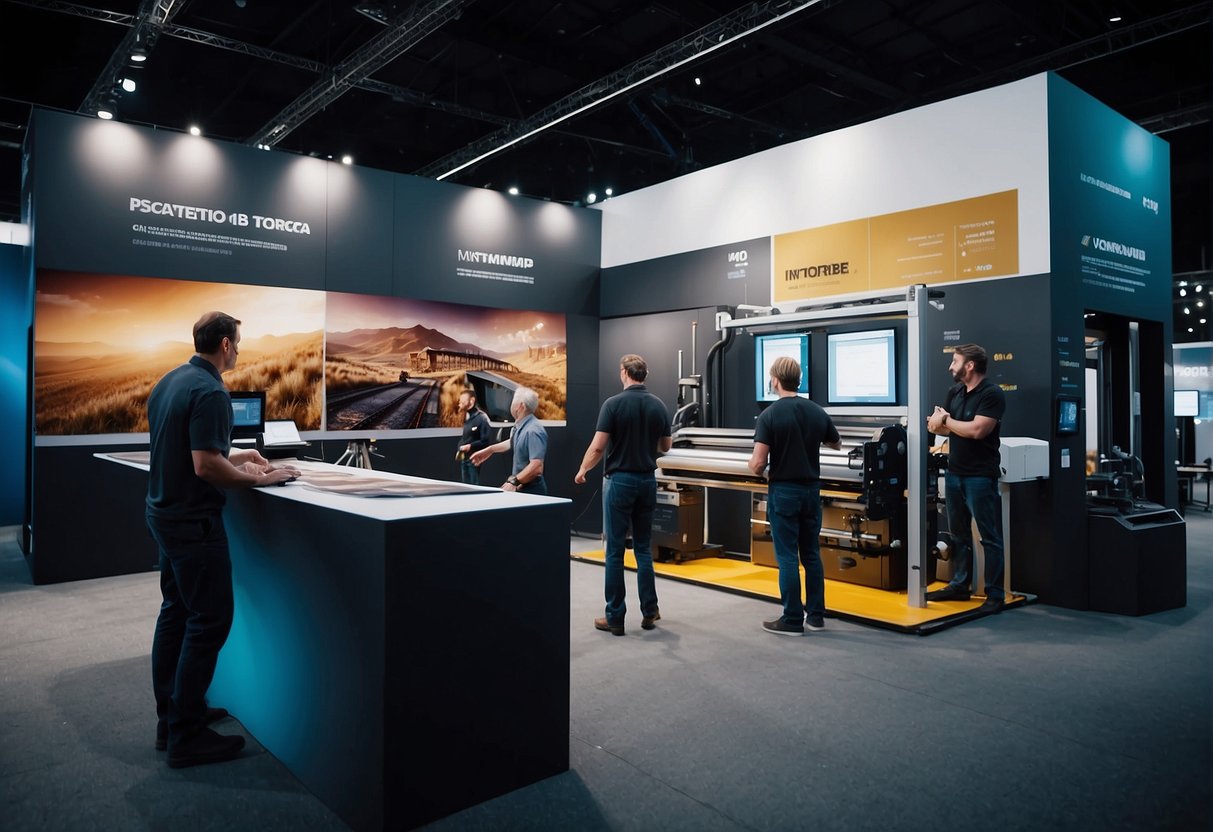
Having standout print materials is dependent on understanding your specific needs for the trade show or conference, incorporating appealing designs, and determining the essential types of print materials required for the event. It’s crucial to focus on elements that will make your materials memorable and effective in portraying a strong brand image. This might include specialty finishes, creative designs, or interactive elements that engage the recipients.
Organizing the logistics of printing and managing timelines is equally vital. Choosing the right printing service can make a significant difference in the quality of your materials and the ease of the process. An experienced printer can provide guidance on material selection, design, and delivery, ensuring your print materials are ready and professionally presented on the day of the event. It’s about building brand presence, enhancing promotional strategies with giveaways, and ultimately, achieving success at your event by leaving a lasting impression on attendees.
Key Takeaways
- Effective conference and trade show print materials reinforce brand identity and provide lasting reminders.
- Design and material choices for print materials can significantly impact brand differentiation and attendee engagement.
- Proper coordination with printing services is essential to ensure timely and high-quality production of event materials.
Understanding Trade Show and Conference Printing Needs
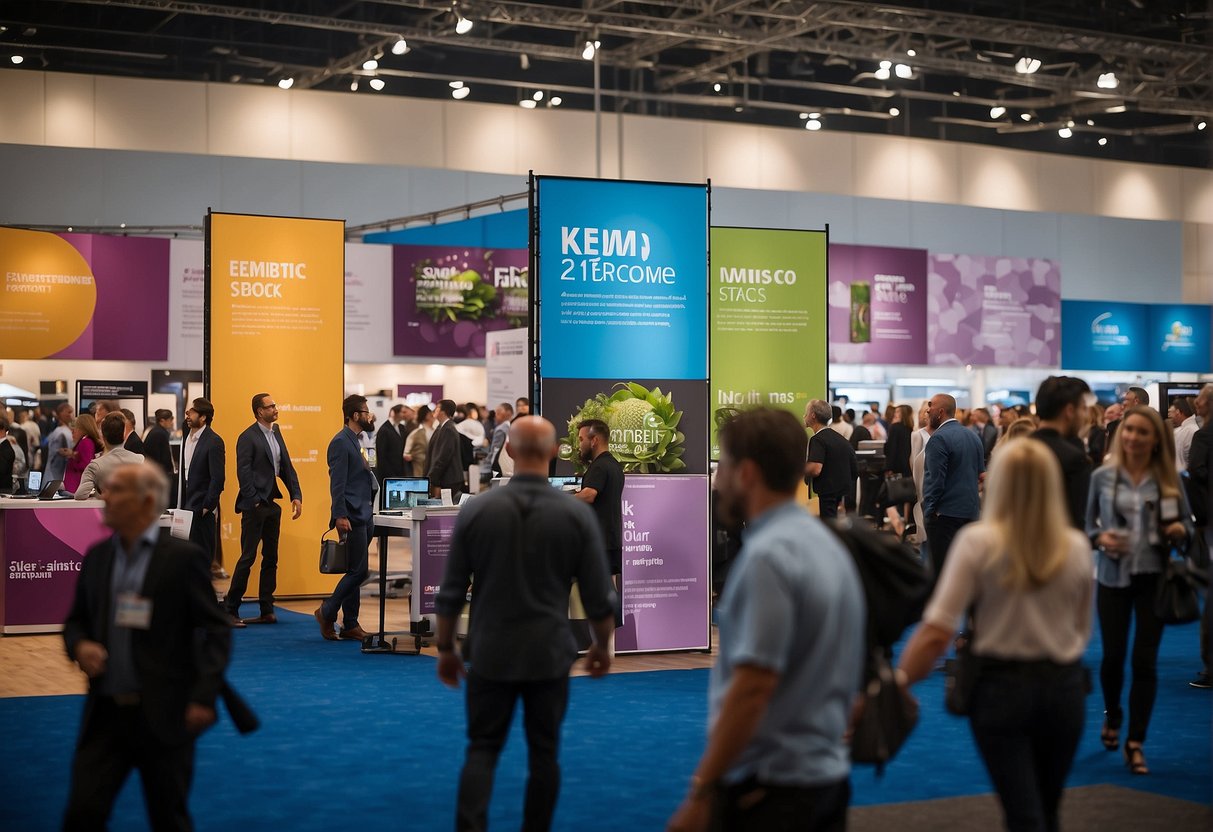
When planning a trade show or conference, one of the essential elements is the creation of visually appealing and informative printed materials. These materials are not only a reflection of the event’s brand but also serve as vital tools for communication and marketing. The range of printing needs varies widely, depending on the scale and objectives of the event.
- Marketing Collateral: It is important for organizers to have high-quality brochures, flyers, and booklets, which provide attendees with information about the event schedule, speakers, and exhibitors.
- Signage: Directional signs, banners, and posters are crucial for navigation and branding throughout the venue. Customized signage should be clear, legible, and consistent with the event’s branding.
- Badges and Tickets: Secure printing of event badges and tickets is necessary to ensure proper identification and access control for participants.
- Conference Materials: For a professional touch, the organizers should provide attendees with printed materials such as agendas, presentation handouts, and notebooks.
Here is a brief checklist for understanding the specific printing needs:
- Assess the Quantity of each printed item required for the event.
- Ensure the Quality of printing reflects the professionalism of the event.
- Determine the Size and Format of the materials for various purposes.
- Verify the Deadline for having all print materials ready and available.
For a successful event, one should coordinate with reputable printing vendors who can deliver all materials on time while adhering to the event’s quality standards. Efficient planning and clear communication with the printer will ensure that all printing needs are met, enhancing the overall experience of the trade show or conference.
Designing Your Marketing Materials

When preparing for a conference or trade show, the design of marketing materials plays a pivotal role in making a strong brand impression. High-quality design can make materials like banners, brochures, and business cards stand out, while a cohesive look ensures that every piece communicates the brand’s message effectively.
Creating a Cohesive Visual Identity
A cohesive visual identity is crucial for any brand. Designers must ensure that logos, color schemes, and typefaces are consistent across all materials, including banners, brochures, business cards, signs, and posters. This uniformity helps in reinforcing the brand’s identity and leaves a lasting impression on the audience.
- Logos: Use high-resolution logo files to avoid pixelation on large formats.
- Color Schemes: Choose vibrant, brand-specific colors that evoke the desired emotion and response.
- Typefaces: Select legible fonts that align with the brand’s character for easy reading.
Choosing the Right Paper Stock and Materials
The physical quality of marketing materials reflects the brand’s attention to detail. It’s important to select the appropriate paper stock and materials that are both durable and aesthetically pleasing.
| Material Type | Recommended Use |
|---|---|
| Glossy Paper | Vibrant posters and high-impact signs |
| Matte Paper | Professional brochures and flyers |
| Cardstock | Sturdy business cards and name badges |
Heavier paper stocks convey luxury and tend to be more durable, while lighter stocks are cost-effective for mass handouts.
Designing for Maximum Impact
The design should aim to capture attention and deliver the brand’s message succinctly. Use a mix of compelling imagery and clear language to convey the brand’s value proposition.
- Use bold headings and bullet points for easy scanning.
- Include high-quality images to create more engaging and visually appealing designs.
- Strive for a balance between written content and visual elements to avoid cluttered layouts.
Design choices directly contribute to the perceived value and quality of both the marketing materials and the brand itself. Effective design fosters engagement and can be a significant driver in the success of a brand’s presence at a conference or trade show.
Essential Printed Materials for Conferences and Trade Shows
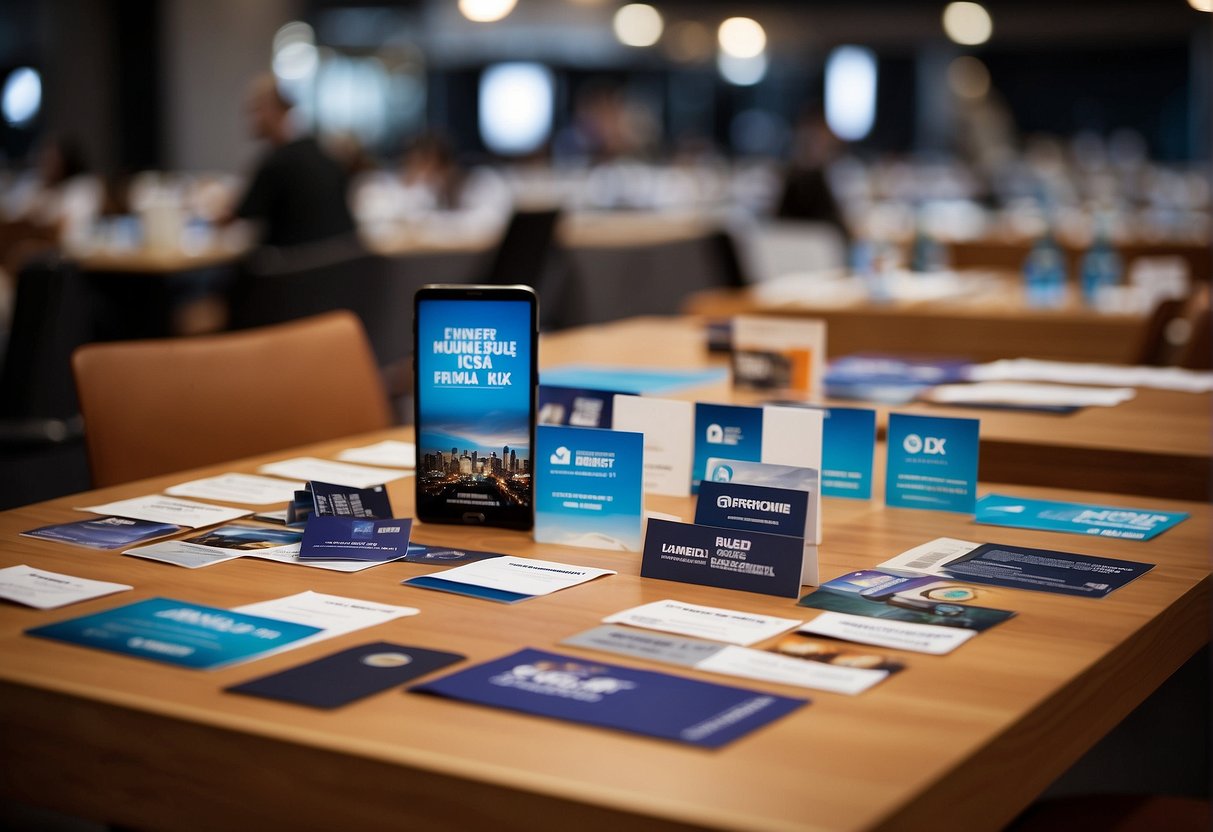
Selecting the right printed materials is crucial for presenting a professional image and effectively conveying your message at a conference or trade show. High-quality, well-designed printouts can significantly enhance brand perception and audience engagement.
Banners and Backdrops
Banners and backdrops serve as the foundation for creating a visually compelling booth. They should be made of durable materials to withstand the duration of the event. A luxurious finish can elevate the brand’s presence. Folds and modular designs ensure easy transport and setup.
Handouts and Flyers
Handouts and flyers are essential for quick distribution and are effective for highlighting key information. Glossy or matte finishes can be chosen based on the visual impact desired. They should be concise, and the design must align with the event’s theme for better recollection.
Business Cards and Sales Sheets
A detailed business card imparts a lasting impression. Business cards and sales sheets should embody the brand’s ethos and provide clear contact information. Saddle-stitched or spiral formats are choices for sales sheets offering detailed product or service information.
Brochures and Booklets
For a comprehensive narrative about the brand, brochures and booklets are indispensable. Options for binding include saddle-stitched, spiral, or perfect bound, with consideration for both tactile feel and durability. They should contain pertinent information to persuade prospects about the brand’s value.
Stand-Out Features for Your Print Materials

To effectively capture the attention of attendees at a conference or trade show, one’s print materials should embody distinct qualities that set them apart. High-quality paper stock and unique finishing touches can substantially elevate the perceived value of printed content.
Special Finishing Options
Print materials often benefit from special finishing options that enhance their visual appeal and tactile experience. Finishing options can range from glossy to matte laminations, providing a durable and polished look. Embossing is another sought-after feature, giving a three-dimensional effect to certain text or design elements. Embossing on uncoated paper introduces an element of sophistication and can make certain details pop.
Finish Types:
- Gloss: High sheen, enhances colors
- Matte: Non-reflective, elegant finish
- Embossing: Raised design feature on paper
Innovative Binding Techniques
The longevity and usability of print materials are heavily influenced by their binding techniques. Different methods cater to various needs, such as ease of use, durability, and presentation quality. Blending classic methodologies with innovative binding techniques can result in functional and memorable print pieces.
Binding Methods:
- Saddle Stitch: For booklets with fewer pages
- Perfect Binding: Creates a flat spine
- Spiral Binding: Allows the material to lay flat when open
Interactive Elements
In an age where digital convenience is valued, incorporating interactive elements like QR codes can bridge the gap between print and digital. A QR code on a brochure or a flyer effortlessly connects potential customers to one’s online resources, enhancing user engagement without cluttering the design.
Interactive Features:
- QR Codes: Directs to online content
- Multiple Folding Options: Unfolds to reveal more information
Each of these features is a tool to strengthen the impact of one’s print materials at trade shows and conferences, creating a memorable experience for the audience.
Logistics of Printing for Trade Shows and Conferences

Meeting the printing needs for trade shows and conferences necessitates careful planning and precision. The key components involve managing timelines effectively and ensuring that shipping and handling procedures are foolproof to maintain a smooth flow of materials essential for business networking and creating connections.
Timelines and Scheduling
When coordinating printing for these events, the importance of setting structured deadlines cannot be overstated. Exhibitors should adhere to the following timeline:
- 120-90 days before event: Define printing needs and quantities.
- 60 days before event: Finalize artwork and submit for printing.
- 30 days before event: Review proofs and make any necessary corrections.
This schedule allows sufficient time for production, addressing any issues, and ensuring everything is ready well ahead of the event start date. It’s imperative for exhibitors to work backwards from the conference date to establish a timeline that renders them ample time for all printing processes.
Shipping and Handling
Shipping and handling of printed materials must be meticulously planned. Below are focused strategies:
- Direct Shipping to Venue: Printed materials are shipped directly to the event location.
- Advantages: Reduces handling and lowers risk of damage.
- Considerations: Venue may have limited storage capacity; check with event organizers.
- Advance Warehouse Shipping:
- Send materials beforehand to a designated warehouse.
- Materials are then transferred to the event site closer to the date.
- Advantages: Less last-minute stress and the potential for consolidating shipments with other materials.
Regardless of the method, exhibitors should always opt for trackable shipping options and consider insuring their materials, especially for fast-paced environments where materials are critical for establishing business connections. They should coordinate with their shipping providers to ensure delivery schedules match the event’s timeline and that handling at the venue is clearly understood, reducing the risk of misplacement or delays.
Building Your Brand Presence
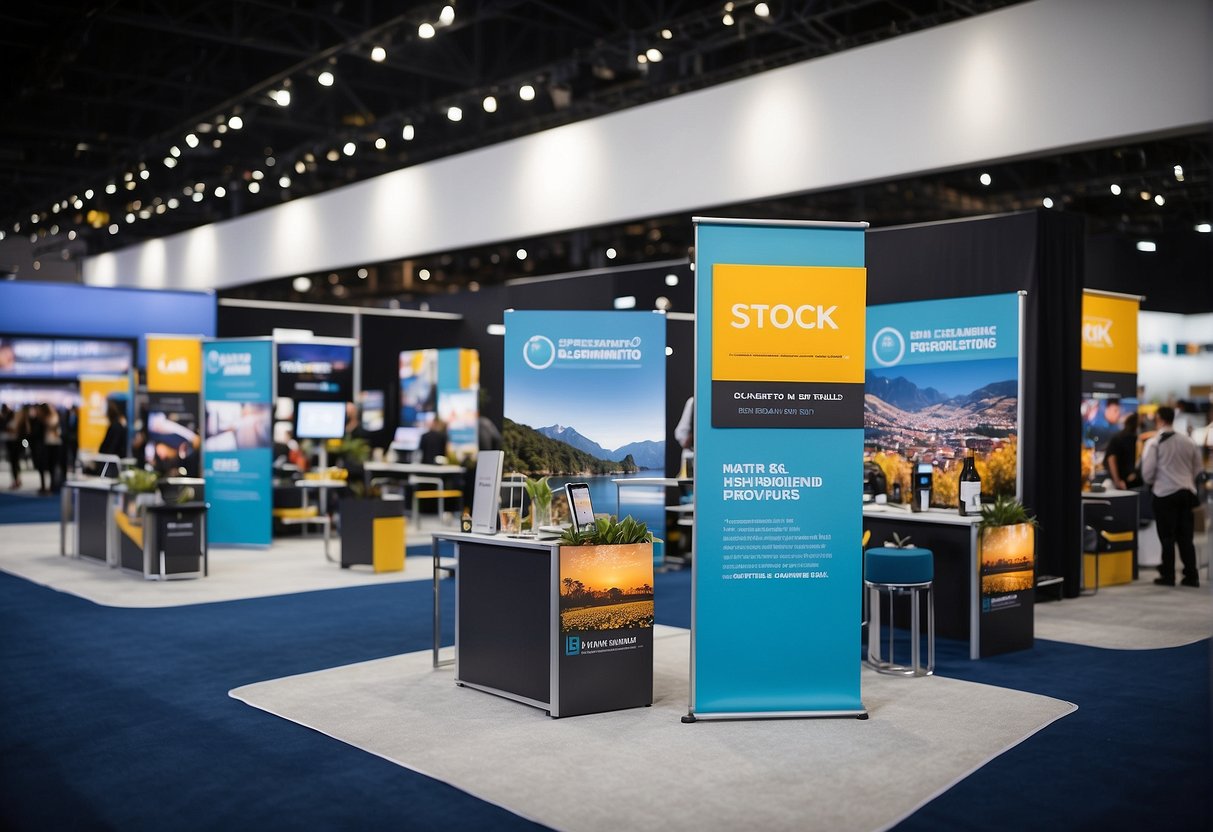
To establish a strong brand presence at your next conference or trade show, it is crucial to create visually striking booth displays and actively seek networking opportunities that can drive business growth. These elements must work in tandem to attract attendees and convert them into potential customers or partners.
Engaging Booth Displays
Exhibitors should design their trade show booths to be not only visually appealing but also reflective of their brand’s message and values. Bold colors, consistent with the brand’s palette, and clear branding elements such as logos and slogans should be prominently featured. Incorporate a mix of engaging elements:
- Visuals: High-resolution images or videos that showcase products or services.
- Interactive Elements: Touchscreens or product demos that invite attendees to experience offerings first-hand.
The booth should be staffed by knowledgeable representatives ready to answer questions, facilitate product demonstrations, and collect leads.
Strategic Networking Opportunities
Effective networking at trade shows is about creating meaningful connections with other businesses, potential customers, and partners. Here are some targeted strategies:
- Pre-Show Outreach: Schedule meetings with key attendees or businesses before the event.
- Networking Events: Attend or host mixers, seminars, and other associated events that are likely to attract potential leads.
- Follow-Up: Organize collected information efficiently to enable prompt follow-up with contacts post-event.
By focusing on these strategic elements, businesses can greatly enhance their brand presence, lead generation, and growth potential at any conference or trade show.
Promotional Products and Giveaways
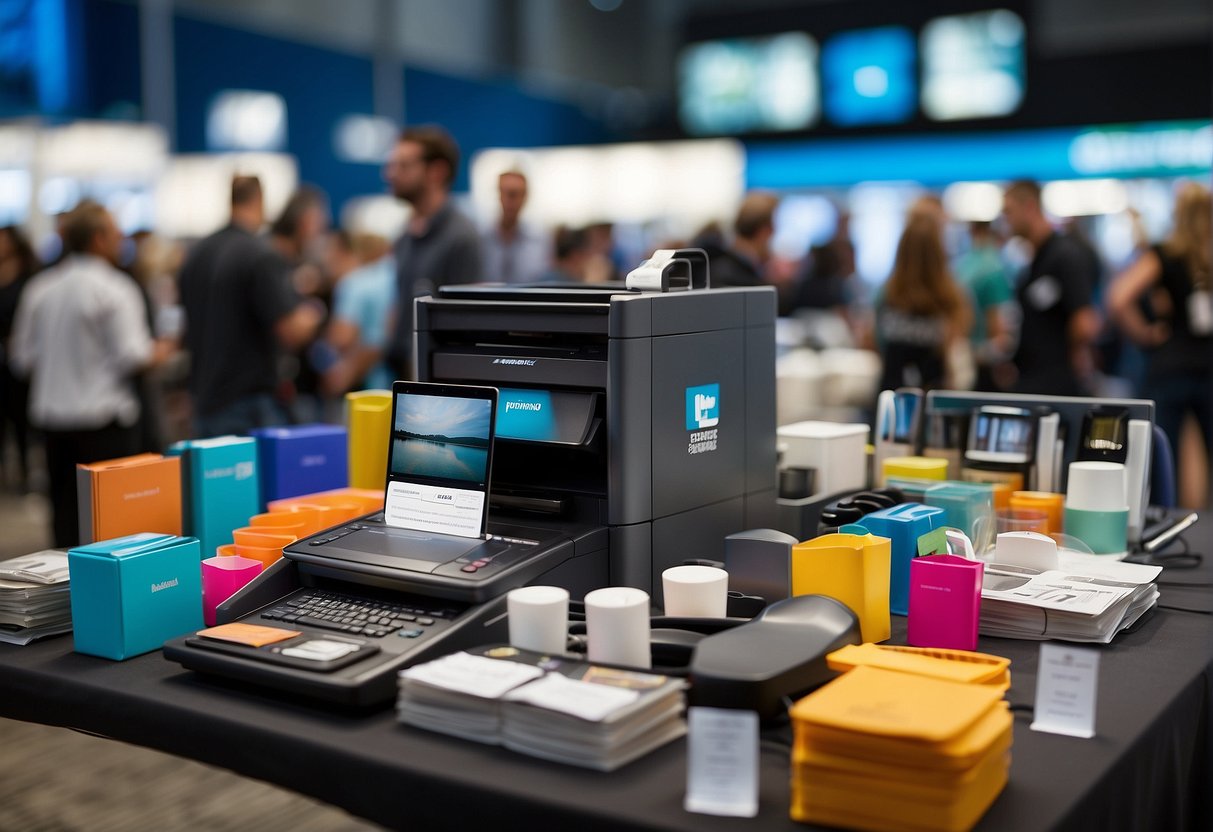
Promotional products and giveaways are key to creating a lasting impression on customers at conferences and trade shows. They should be both memorable and informative, serving as a tangible representation of a business.
Selecting Appropriate Giveaways
When choosing giveaways, one should consider the interests and needs of the target audience. It’s essential that these items are not only appealing but also practical, ensuring they are used by recipients long after the event, thus keeping the business top of mind. Popular choices include USB drives, branded pens, and notebooks.
The quality of materials used should reflect the company’s image—opting for durable, high-quality items is often more effective than distributing a large quantity of low-quality products. Items like stainless steel water bottles or branded tote bags can convey a message of reliability and environmental consciousness.
Incorporating Business Information
Promotional items must serve as a tool for brand recognition and business information dissemination. When incorporating business info, one must ensure key details such as the company name, logo, contact information, and a catchy tagline are visible.
Display Options for Giveaways:
| Stand Type | Ideal for |
|---|---|
| Retractable Banners | Quick, portable information display; easy to setup |
| Pop-up Displays | Eye-catching, 3D structure for interactive setups |
| Informational Booklets | Detailed company information and special offers |
Bold colors and clear typography can help stand out in a busy trade show environment. Materials should include the business’s distinct branding and are most effectively presented on a professional display or stand, such as retractable banners or pop-up displays, where they are easily accessible and visually prominent.
Achieving Success at Your Next Event
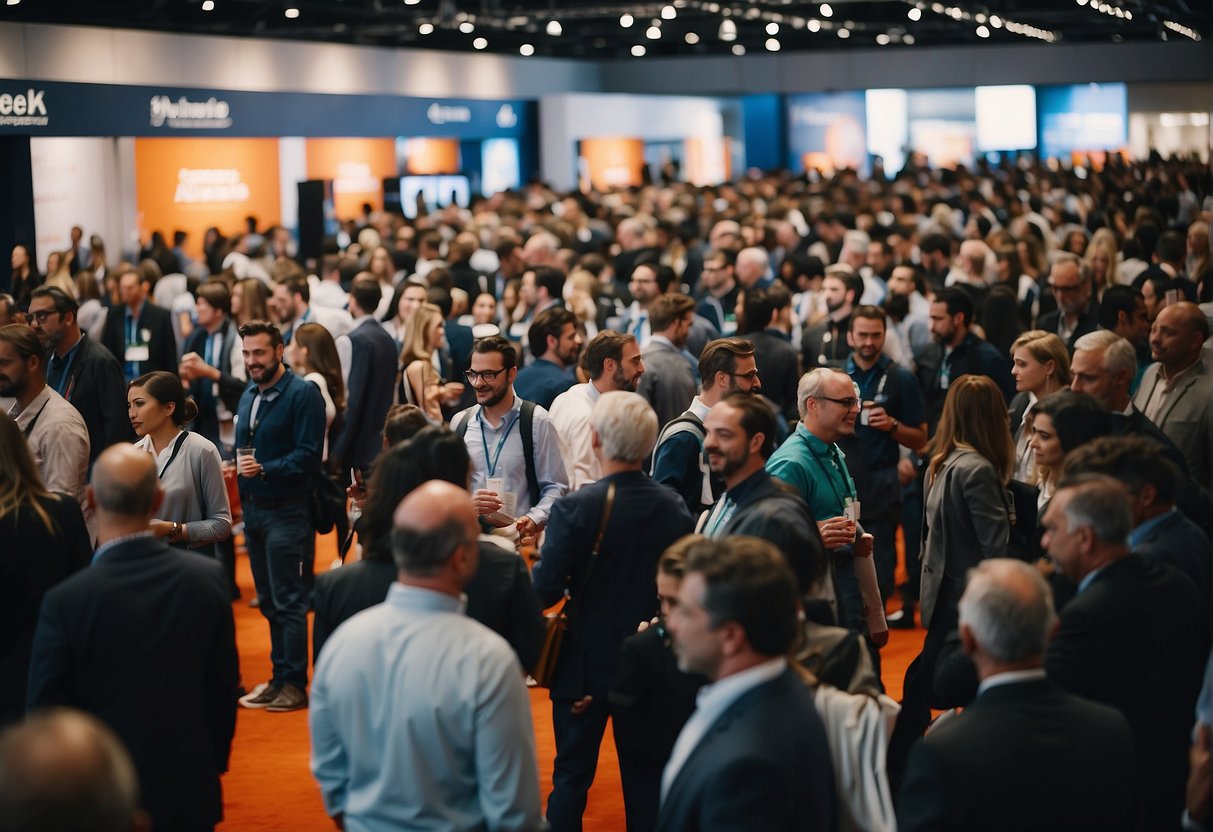
To ensure success at your next event, one must prioritize attendee engagement and accurately measure outcomes. These strategies facilitate growth, enhance attendee satisfaction, and potentially increase profit margins.
Effective Engagement Strategies
Effective engagement with attendees is the cornerstone of a successful conference or trade show. Organizers should leverage interactive marketing events to captivate the crowd. Tactics may include:
- Live Demonstrations: Enabling hands-on experiences generates positive feedback and maintains interest.
- Q&A Sessions: Encouraging dialogue between speakers and attendees fosters a long-lasting connection.
- Networking Opportunities: Designated networking zones where attendees can interact with peers, leads, and investors, for example:
Time Location Focus 10:00 AM Zone A Investor Meet 12:30 PM Zone B Tech Innovations 03:00 PM Main Hall Industry Trends - Gamification: Incorporate elements of play to engage participants, such as leaderboards for social media mentions or interactive polls.
Measuring Event Outcomes
Quantifying the success of an event is critical for plotting future strategies. Key performance indicators (KPIs) should be established to track:
- Lead Generation: A tally of the leads collected can indicate the event’s effectiveness in expansion efforts.
- Attendee Satisfaction: Surveys or feedback forms can measure satisfaction levels, helping organizers to refine future events.
- Investor Interest: The number of inquiries or meetings set up with potential investors can signal growth potential.
- Profit Analysis: Comparing the revenue generated against the event costs provides a clear picture of the financial outcome.
Working with Printing Services
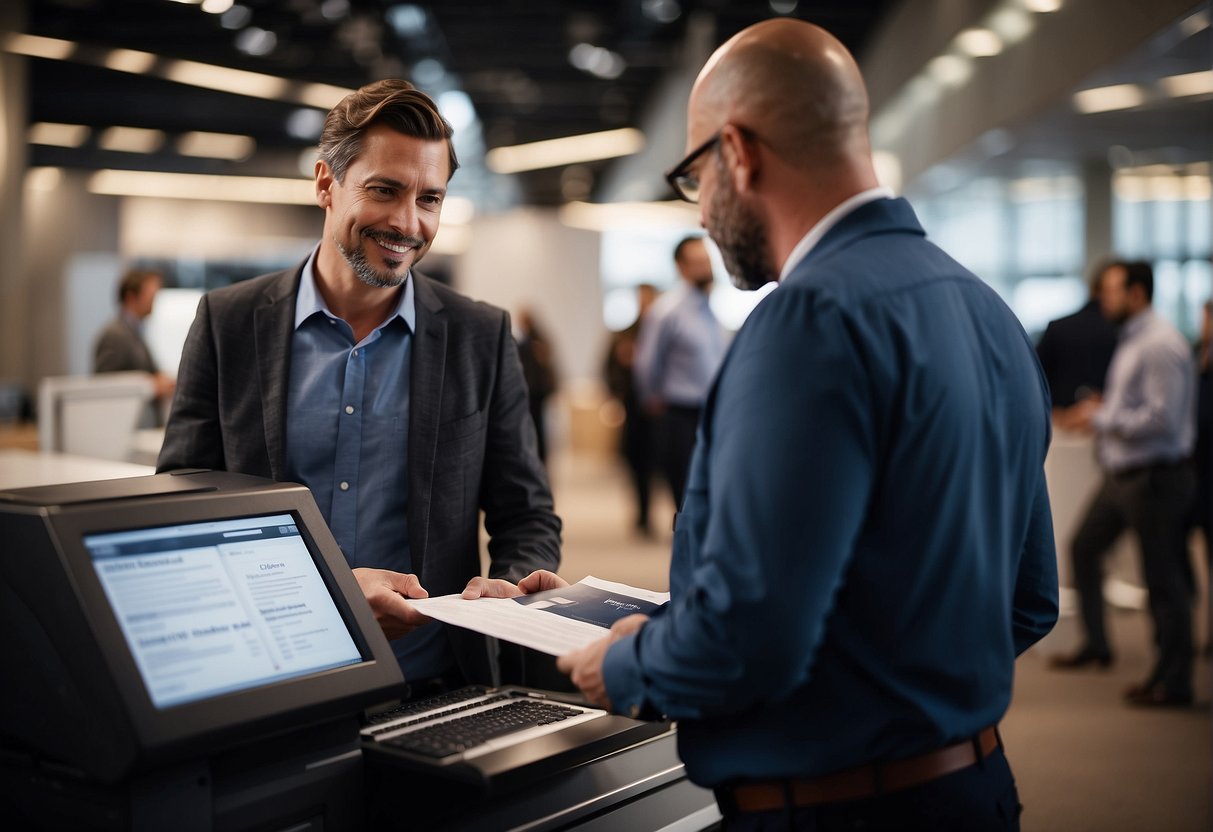
When organizing materials for a conference or trade show, one must prioritize working with reliable printing services. It’s crucial to ensure the quality of print materials reflects the professionalism of the event. High-quality printing can leave a lasting impression, making it essential to select a printing company that upholds superior standards for their products.
Choosing the Right Printing Service:
- Look for companies known for fast turnaround times.
- Ensure they offer a variety of size options to fit different needs.
- Confirm the availability of diverse surface types suited for your specific use cases.
A clear proof process is vital. The service should provide digital or physical proofs, allowing for adjustments before the final print. This step is key to avoid any potential errors or miscommunication.
Print Materials Checklist:
- Business cards
- Brochures
- Banners
- Signage
To facilitate an easy experience, one should assess the printing service’s user interface for simplicity and efficiency. Additionally, verifying the company’s capability to meet your event’s scale needs is necessary to ensure they can handle the job without compromising speed or quality.
In conclusion, selecting the right printing service for your event requires a balanced consideration of quality, speed, variety, and reliability. With careful planning and coordination, print materials produced will effectively complement the professional ambiance of any conference or trade show.
Frequently Asked Questions
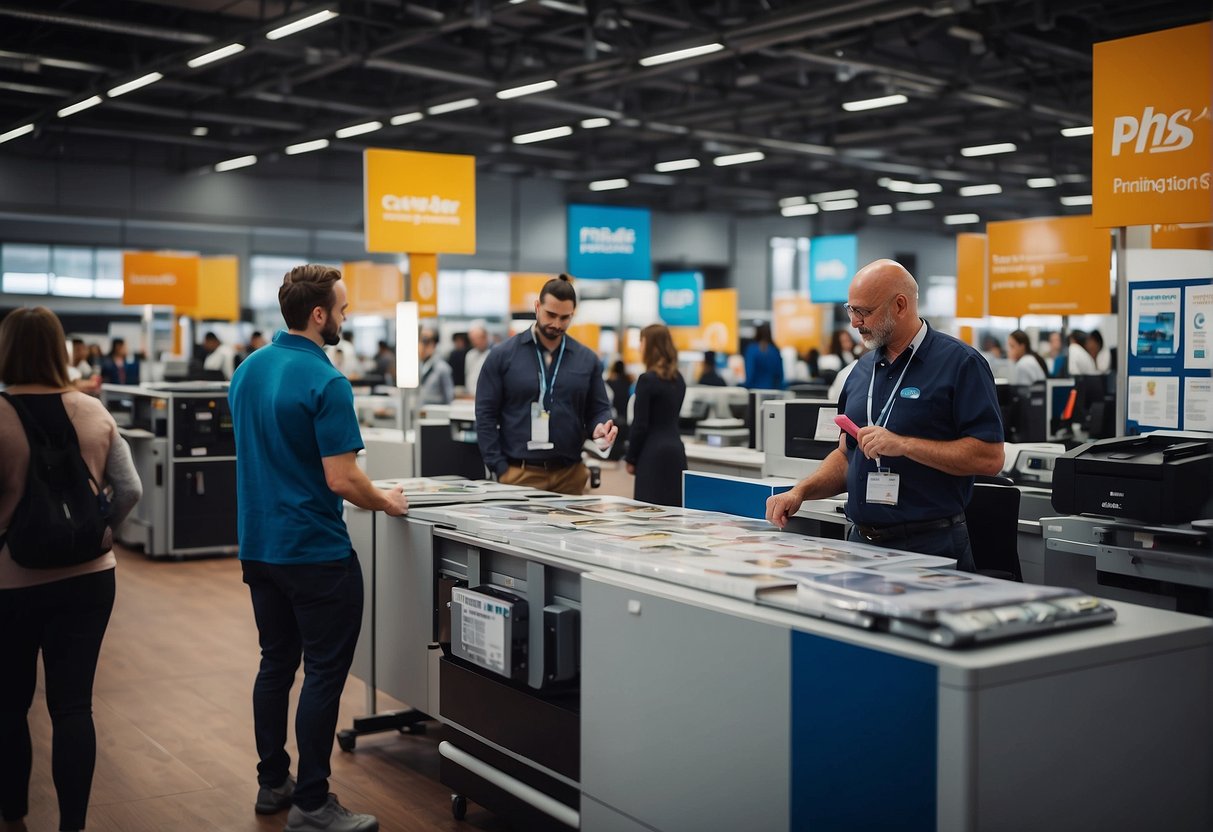
This section addresses common inquiries with specific advice on various aspects of printing for trade shows and conferences.
What are the best strategies for sourcing reliable print vendors for trade shows?
When searching for print vendors, look for those that specialize in trade show materials and have a portfolio of their work. They should have a record of meeting tight deadlines and be able to provide testimonials from previous clients.
How can I design effective banners for trade shows that stand out?
Designing effective banners involves using high-resolution images, clear fonts, and a color scheme that aligns with your brand. The message should be concise and easily readable from a distance to capture the attention of attendees quickly.
What are the latest trends in trade show signage for maximum attendee engagement?
Interactive and digital signage are trending, with QR codes for downloading additional content and LED screens that engage attendees. Reusable materials are also popular for sustainable brand presence.
Can you recommend any customizable banner templates suitable for trade shows?
Many online printing services offer customizable templates that can be tailored to suit the needs of a trade show exhibition. These templates ensure that the banners are properly sized and formatted for print.
What differentiates trade shows from conferences and how does it affect exhibitor preparation?
Trade shows focus on product exhibitions and sales, while conferences center around discussions and presentations. Exhibitors at trade shows should prepare eye-catching and product-focused materials, whereas conference preparations might be more information and brand-focused.
Where should I look to find quality retractable banners for trade show exhibitions?
For quality retractable banners, seek out suppliers that use durable materials and offer a variety of sizes. Online reviews and industry recommendations may guide you to vendors with high-quality products and reliable services.
